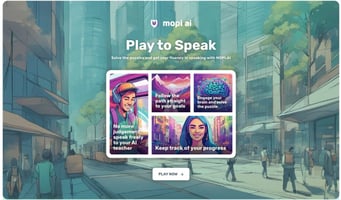Unlock the joy of language learning with Mopi.ai Picture this: You’re at a bustling market in...
Gamification in language learning: making learning fun and effective
Let’s face it—learning a language can sometimes feel like a tedious process. Memorizing vocabulary lists, practicing grammar rules, and repeating pronunciation drills may not sound like the most exciting way to spend your time. But what if language learning could feel like a game? That’s the promise of gamification, a revolutionary approach that makes the process of mastering a new language engaging, fun, and highly effective. In this article, we’ll explore how gamification is transforming language learning and why it works so well.
What is gamification?
Gamification is the process of incorporating game-like elements into non-game activities. In the context of language learning, it involves using features like points, badges, leaderboards, levels, and challenges to motivate learners. By turning learning into a game, apps like Mopi.ai keep users engaged and encourage them to progress through their language journey.
How gamification enhances engagement?
A key challenge in language learning is maintaining motivation over the long term. Traditional methods often fail to keep learners engaged, but gamification offers a solution. According to research, gamified learning environments create a sense of excitement and competition, which drives users to stay consistent. Earning rewards, unlocking new levels, and achieving milestones make the learning process enjoyable and rewarding.
For example, Mopi.ai encourages users to complete conversations with virtual characters and collect objects as they progress through their language adventure. This turns every lesson into a mission, keeping learners motivated to achieve their goals.

Making learning effective through practice.
Gamification isn’t just fun—it’s highly effective. Studies show that incorporating game-like elements helps learners retain information better. By presenting vocabulary and grammar in a gamified format, learners engage more deeply with the material and are more likely to remember what they’ve learned. For instance, completing a conversation challenge in a simulated real-world scenario reinforces practical language skills in a way traditional methods can’t.
Building confidence through challenges.
One of the most significant benefits of gamification is its ability to build learners’ confidence. Challenges and tasks are designed to gradually increase in difficulty, ensuring users are constantly improving without feeling overwhelmed. Gamified systems also provide instant feedback, so learners know what they’re doing well and where they need to improve. This fosters a growth mindset and encourages users to keep going.
Fostering community and collaboration.
Gamification often includes social elements, such as leaderboards and group challenges, which foster a sense of community. Competing with others or collaborating to achieve shared goals makes learning more interactive and fun. In Mopi.ai, users can compare their progress with friends, creating healthy competition that motivates everyone to keep learning.
Conclusion:
Gamification is revolutionizing language learning by combining fun and effectiveness in a way that traditional methods cannot. By turning lessons into engaging challenges, fostering a sense of progress, and building a community of learners, gamified apps like Mopi.ai make mastering English an exciting adventure.
If you’re ready to enjoy learning English while achieving real results, dive into the gamified world of Mopi.ai. Language learning has never been this fun—or this effective.




